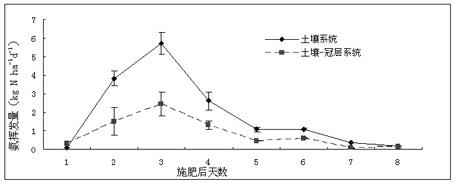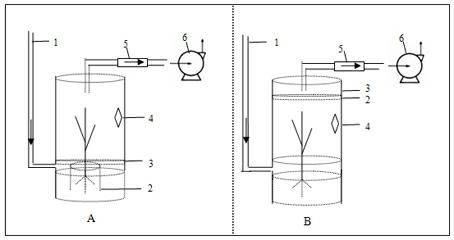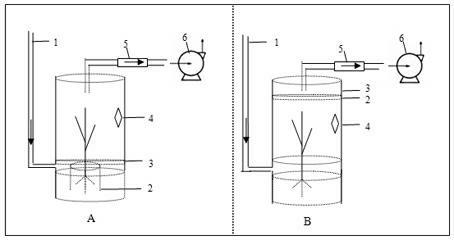Device and monitoring method for in-situ research on ammonia exchange in crop canopy
A crop canopy and ammonia exchange technology, which is applied in the direction of material analysis by observing the influence of chemical indicators, and analysis by making materials undergo chemical reactions, can solve the problem of expensive equipment, powerlessness, and inability to include canopy and other issues to achieve the effect of reducing water pollution and increasing fertilizer efficiency
- Summary
- Abstract
- Description
- Claims
- Application Information
AI Technical Summary
Problems solved by technology
Method used
Image
Examples
Embodiment 1
[0020] The device for studying the ammonia exchange of the crop canopy in situ in the field includes an airtight cultivation cover and a dilute acid carrier 3, an air intake pipe 1 is arranged on the side wall of the cultivation cover close to the surface, and an exhaust hole is arranged on the top of the cultivation cover, and the exhaust hole is connected with the The vacuum pump 6 is connected, and the brackets 2 for fixing the dilute acid carrier 3 are respectively provided at the end close to the ground surface and the end close to the exhaust hole in the culture hood. Thermometers and hygrometers are arranged on the inner and outer walls of the culture cover. The dilute acid carrier is sponge. The dilute acid carrier has the same dimensions as the cross-sectional area of the culture hood. A flow meter (5) is arranged on the connecting pipe between the exhaust hole and the vacuum pump. The dilute acid is orthophosphoric acid, sulfuric acid or oxalic acid. The lower e...
Embodiment 2
[0023] The monitoring method of the device for in-situ research on the ammonia exchange of the crop canopy in the field. When the ammonia exchange is monitored at a certain stage of plant growth, the pre-prepared carriers soaked in dilute acid are placed on the lower bracket of the culture cover of group A respectively. On the upper support of the culture hood of Group B and Group B, the plants of Group A are in the middle of the carrier, and the contact part is isolated with polyethylene plastic, and then the vacuum pump is turned on to pump air to keep the temperature and humidity inside and outside the growth chamber close and ensure that there is no fog in the growth chamber. Set the pumping time according to the needs of the research. After the pumping is over, take off the culture cover, shake and extract the carriers of the two groups with deionized water, and measure the amount of ammonia adsorbed by ultraviolet spectrophotometer and indophenol blue colorimetry. Get the...
Embodiment 3
[0025] Monitoring example: Study on ammonia exchange monitoring of rice canopy after fertilization in rice fields
[0026] The rice is cultivated in a PVC cylinder with a diameter of 30cm, the lower part is buried in the soil, and the upper part is exposed to the ground. There is an air inlet with a diameter of 3cm above the cylinder, which is divided into two groups, one of which is used to monitor the ammonia emission on the soil surface , a stainless steel bracket is embedded in the PVC cylinder, on which can be placed sponges adsorbed with dilute acid (referred to as group A); The difference between the amounts is the ammonia exchange amount of the canopy, a positive value indicates that the canopy absorbs gaseous ammonia, and a negative value indicates that the canopy emits ammonia.
[0027] Topdressing was performed at the tillering stage after rice transplanting, with a fertilization rate of 6 kg N / mu. After fertilization, the ammonia exchange of rice canopy was monitor...
PUM
 Login to View More
Login to View More Abstract
Description
Claims
Application Information
 Login to View More
Login to View More - R&D
- Intellectual Property
- Life Sciences
- Materials
- Tech Scout
- Unparalleled Data Quality
- Higher Quality Content
- 60% Fewer Hallucinations
Browse by: Latest US Patents, China's latest patents, Technical Efficacy Thesaurus, Application Domain, Technology Topic, Popular Technical Reports.
© 2025 PatSnap. All rights reserved.Legal|Privacy policy|Modern Slavery Act Transparency Statement|Sitemap|About US| Contact US: help@patsnap.com



